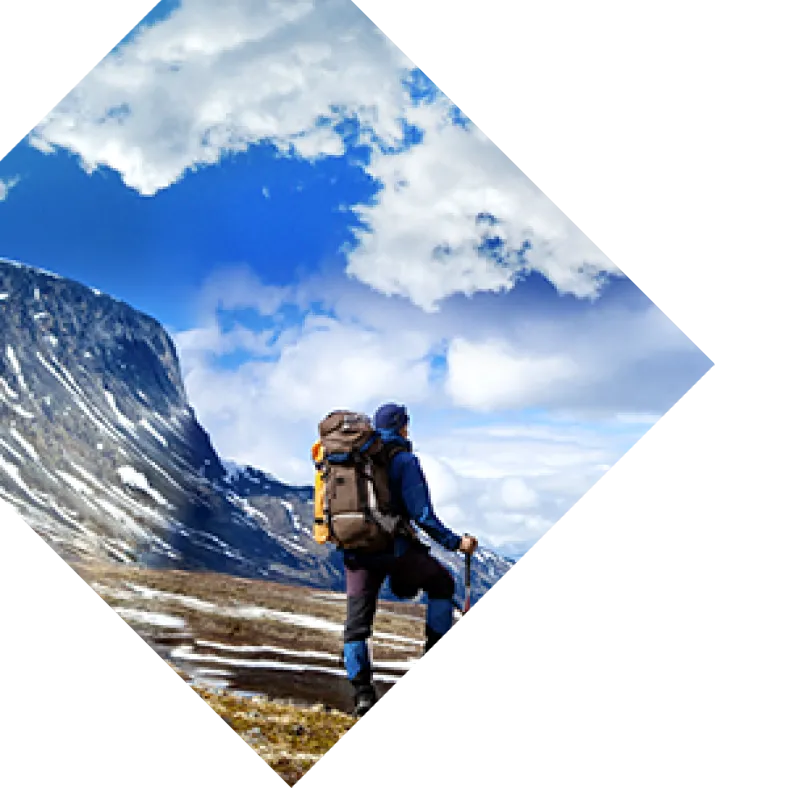But when you're a guy who aspires to experience all there is in life, there was one particular winter activity missing on my to-do list. I wanted to do something that involved my four-legged friends running through a winter wonderland. 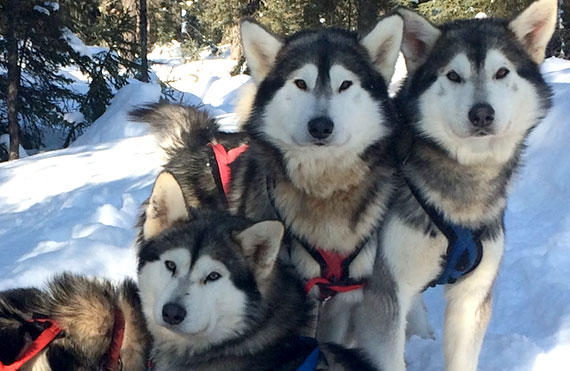 When I first signed up for a dog sledding excursion in the frigid boreal forest of eastern Canada, I had the melody of “Jingle Bells" in my head, with alternate lyrics: Dashing through the snow… In a four dog open sleigh… O'er the fields we go… Laughing all the way… However, the idyllic winter images of prancing snow dogs and smiling, rosy-cheeked faces that conjured in my mind, quickly faded when I was faced with the reality of mushing. It can actually be more of a challenge than playtime on a snow day. “YOU DID THIS! THAT'S YOUR FAULT!" scolded Julien Gravelle, my mushing instructor with Aventuraid, an adventure outfitter based in Girardville, Québec, on the border of the boreal forest. He spoke in a stern voice above the loud barking. Having failed to unanchor a snow hook, I had inadvertently caused two dogs to get twisted—and almost strangled—by ropes, leading them to bite at each other in frustration. Suddenly the virgin white powder was marked with disturbing drops of red blood. I did that. That was my fault. Fortunately, Gravelle rushed to the rescue and released the snow hook, relieving the rope tension to untangle the dogs. They calmed down.
When I first signed up for a dog sledding excursion in the frigid boreal forest of eastern Canada, I had the melody of “Jingle Bells" in my head, with alternate lyrics: Dashing through the snow… In a four dog open sleigh… O'er the fields we go… Laughing all the way… However, the idyllic winter images of prancing snow dogs and smiling, rosy-cheeked faces that conjured in my mind, quickly faded when I was faced with the reality of mushing. It can actually be more of a challenge than playtime on a snow day. “YOU DID THIS! THAT'S YOUR FAULT!" scolded Julien Gravelle, my mushing instructor with Aventuraid, an adventure outfitter based in Girardville, Québec, on the border of the boreal forest. He spoke in a stern voice above the loud barking. Having failed to unanchor a snow hook, I had inadvertently caused two dogs to get twisted—and almost strangled—by ropes, leading them to bite at each other in frustration. Suddenly the virgin white powder was marked with disturbing drops of red blood. I did that. That was my fault. Fortunately, Gravelle rushed to the rescue and released the snow hook, relieving the rope tension to untangle the dogs. They calmed down. 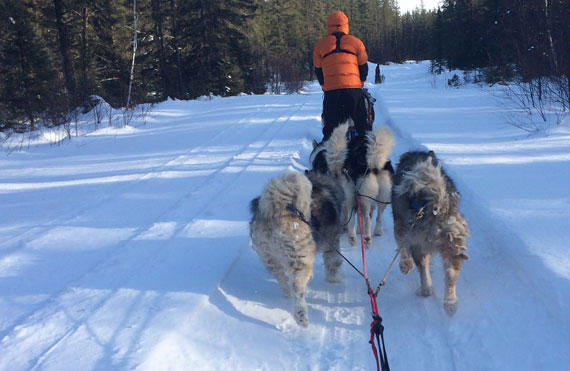 This was just one mishap in a series of many during my four-day crash course in mushing. Prior to the trip, friends who had already gone dog sledding convinced me that it would be a postcard image of relaxed riding in a sled while happy huskies pulled me through a winter wonderland. However, they had been in the controlled environment of a ski resort. When you're actually mushing yourself in the wild, or trying to learn anyway, it's not so easy. There's plenty to worry about—from steering around muddles of trees, to keeping your balance on the sled's runners when gliding over uneven, unpacked snowy terrain, to maintaining a good relationship with your team of dogs—and all at temperatures that can drop to 30 below. The frostbite I'd get in the small slits of exposed skin between articles of clothing stung like paper cuts. “On y va!" (Let's go!) I cried out to my dogs in the French they were accustomed to hearing. With all my ropes and anchors in order, we slowly started our trek, a 24-mile circuit of thick woods, frozen lakes, and the marshland in between, to battle the winter elements as a fledgling team.
This was just one mishap in a series of many during my four-day crash course in mushing. Prior to the trip, friends who had already gone dog sledding convinced me that it would be a postcard image of relaxed riding in a sled while happy huskies pulled me through a winter wonderland. However, they had been in the controlled environment of a ski resort. When you're actually mushing yourself in the wild, or trying to learn anyway, it's not so easy. There's plenty to worry about—from steering around muddles of trees, to keeping your balance on the sled's runners when gliding over uneven, unpacked snowy terrain, to maintaining a good relationship with your team of dogs—and all at temperatures that can drop to 30 below. The frostbite I'd get in the small slits of exposed skin between articles of clothing stung like paper cuts. “On y va!" (Let's go!) I cried out to my dogs in the French they were accustomed to hearing. With all my ropes and anchors in order, we slowly started our trek, a 24-mile circuit of thick woods, frozen lakes, and the marshland in between, to battle the winter elements as a fledgling team. 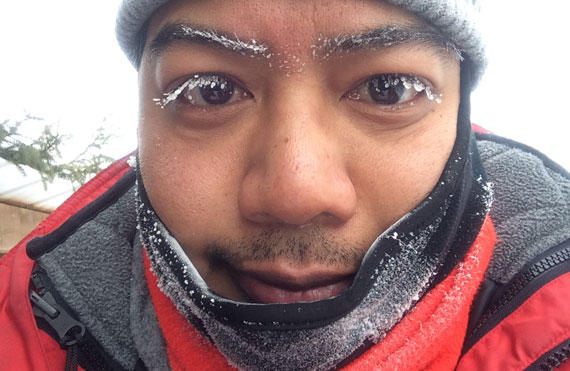 My quartet of Alaskan Malamutes—Hawk, Krye, Skout, and Gingko—were four of 75 from the kennel at Aventuraid. It was with them that I, along with two other newbies each with his and her own quartet of dogs, connected with Gravelle to follow in the footsteps of the French pioneers of the region. Dog sledding is often associated with Alaska. The state hosts the famed Iditarod dog sledding race, after all—a nearly 100-mile route between Anchorage and Nome. But its origins in Western civilization come from the French. In fact, the term “mush" is actually a mishearing of the French command “marche!" meaning to walk, or march, which was ultimately adopted as the English verb for dog sledding. It was the intrepid French traders and settlers of 18th century North America who started "mushing" with dog-drawn sleds, which became a widely-used mode of transportation to move people and goods over vast snow-covered areas. They adapted the idea from indigenous people and used the method to travel over land in what eventually became French-speaking Québec.
My quartet of Alaskan Malamutes—Hawk, Krye, Skout, and Gingko—were four of 75 from the kennel at Aventuraid. It was with them that I, along with two other newbies each with his and her own quartet of dogs, connected with Gravelle to follow in the footsteps of the French pioneers of the region. Dog sledding is often associated with Alaska. The state hosts the famed Iditarod dog sledding race, after all—a nearly 100-mile route between Anchorage and Nome. But its origins in Western civilization come from the French. In fact, the term “mush" is actually a mishearing of the French command “marche!" meaning to walk, or march, which was ultimately adopted as the English verb for dog sledding. It was the intrepid French traders and settlers of 18th century North America who started "mushing" with dog-drawn sleds, which became a widely-used mode of transportation to move people and goods over vast snow-covered areas. They adapted the idea from indigenous people and used the method to travel over land in what eventually became French-speaking Québec.
When you're actually mushing yourself in the wild, or trying to learn anyway, it's not so easy."
Nowadays, snowmobiles reign supreme all over the eastern Canadian province, which boasts more than 20,000 miles of designated snowmobile trails. Still, a few outfitters keep the tradition of French dog sledding alive for those tourists yearning for some old-fashioned adventure. “Allez!" I called out to the four canines pulling my sled (it also means “let's go!"), trying to get them to move faster so I could keep up with Gravelle's sled out front. The dogs, however, while used to running in the forest terrain of small hills and varying depths of snow, maintained their pace.  Gravelle often made stops for us to catch up and to allow the dogs a breather. During our longer midday rest stop each day, we'd trudge through the snow in search of dead branches and trunks to chop into lunchtime firewood for cooking and warmth. At night, we'd continue to use our own muscle to drill for drinking water through the thick layers of ice atop gelid lakes using a hand-powered ice auger. It's all part of the musher's lifestyle, defined by cohabitation with the forest, regardless of the fact that all of its moisture is frozen. On a normal subzero day, chores weren't so bad—even the ones involving feeding dogs and cleaning up dog poop—once repetition evolved them into normalcy. But they were a real challenge on days that brought bone-chilling conditions I hadn't experienced before: freezing temps that made the vapors of my breath rise from my face mask and freeze solid as they condensed on my eyelashes. Fortunately, we sheltered each night in Aventuraid's established log cabins, protecting us from hypothermia and the elements. After a well-deserved meal of kibble mixed with boiled lake water, the dogs slept outside, practically impervious to cold. Malamutes are built for arctic conditions, and it's evident that they love playing in the snow when you see their smiles and wagging tails. But you have to play along nicely. You can't just start barking orders at them, which I did to try and make them run faster.
Gravelle often made stops for us to catch up and to allow the dogs a breather. During our longer midday rest stop each day, we'd trudge through the snow in search of dead branches and trunks to chop into lunchtime firewood for cooking and warmth. At night, we'd continue to use our own muscle to drill for drinking water through the thick layers of ice atop gelid lakes using a hand-powered ice auger. It's all part of the musher's lifestyle, defined by cohabitation with the forest, regardless of the fact that all of its moisture is frozen. On a normal subzero day, chores weren't so bad—even the ones involving feeding dogs and cleaning up dog poop—once repetition evolved them into normalcy. But they were a real challenge on days that brought bone-chilling conditions I hadn't experienced before: freezing temps that made the vapors of my breath rise from my face mask and freeze solid as they condensed on my eyelashes. Fortunately, we sheltered each night in Aventuraid's established log cabins, protecting us from hypothermia and the elements. After a well-deserved meal of kibble mixed with boiled lake water, the dogs slept outside, practically impervious to cold. Malamutes are built for arctic conditions, and it's evident that they love playing in the snow when you see their smiles and wagging tails. But you have to play along nicely. You can't just start barking orders at them, which I did to try and make them run faster. 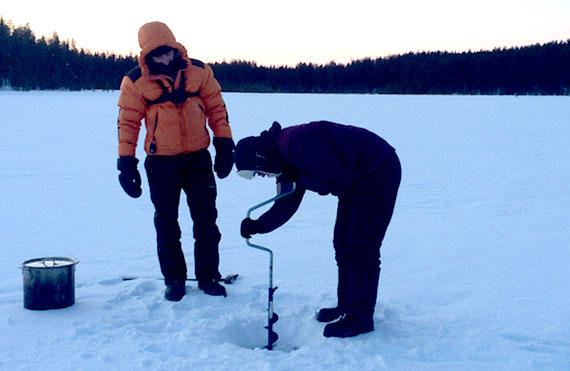 “Rrrrorrrrrorrrorrrorrrorrr!" I was trying to imitate Gravelle after I noticed that he was barking with his team, inspiring them to double-time it. However, my woofs did not get the same reaction. In fact, one of my lead dogs, Hawk, slowed down and kept looking back at me. Gravelle told me what was going on. Apparently, I was barking at my dogs, not with them. Was it my American accent? Apologies were in order, and I was instructed to give them words of encouragement, in simple French, as I would a pet at home. “Très bien, Hawk! Bien!" (Very good, Hawk! Good!) As the leader of my sled, it's actually he that's the intrepid one; a musher is nothing without his team of dogs. I learned that I had to let them know I was merely the human component of it.
“Rrrrorrrrrorrrorrrorrrorrr!" I was trying to imitate Gravelle after I noticed that he was barking with his team, inspiring them to double-time it. However, my woofs did not get the same reaction. In fact, one of my lead dogs, Hawk, slowed down and kept looking back at me. Gravelle told me what was going on. Apparently, I was barking at my dogs, not with them. Was it my American accent? Apologies were in order, and I was instructed to give them words of encouragement, in simple French, as I would a pet at home. “Très bien, Hawk! Bien!" (Very good, Hawk! Good!) As the leader of my sled, it's actually he that's the intrepid one; a musher is nothing without his team of dogs. I learned that I had to let them know I was merely the human component of it. 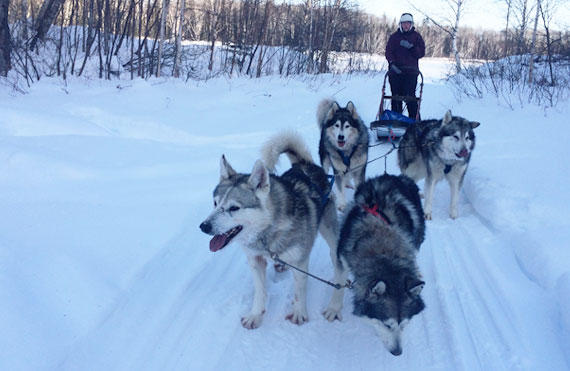 Using my back leg to push against the ground behind me, I applied enough pressure to the sled to let my dogs know I was sharing some of the burden. Gradually, my dogs got accustomed to me driving the sled, and together we really started to gain speed, especially on long stretches over wide ice fields or frozen marshes unobstructed by trees. My dogs galloped gracefully and playfully with their tails wagging behind them. If I could read their minds, I would have deduced that they were actually having fun with me. Finally, the postcard image of dog sledding! Not only that, but I finally got some words of encouragement from Gravelle. "You guys are good drivers," he said.
Using my back leg to push against the ground behind me, I applied enough pressure to the sled to let my dogs know I was sharing some of the burden. Gradually, my dogs got accustomed to me driving the sled, and together we really started to gain speed, especially on long stretches over wide ice fields or frozen marshes unobstructed by trees. My dogs galloped gracefully and playfully with their tails wagging behind them. If I could read their minds, I would have deduced that they were actually having fun with me. Finally, the postcard image of dog sledding! Not only that, but I finally got some words of encouragement from Gravelle. "You guys are good drivers," he said.
My dogs followed the trail blazed by the lead sled, causing my sled to swing around the tight bend like a pendulum from a pivot."
However, when the wide-open frozen lake terrain ended, Gravelle's dogs made a sharp 90-degree turn back into the woods, and the reverie ended. My dogs followed the trail blazed by the lead sled, causing my sled to swing around the tight bend like a pendulum from a pivot. Losing control, I fell off the back while Hawk & co. continued to run forward. “Runaway sled!" I announced, not knowing how to say it in French. I chased my dogs with all the energy I could muster in those cold conditions. Fortunately, the sled had packed the snow down a bit and I was able to get some traction. I leapt forward and grabbed the sled's handlebar, but couldn't get my footing on the runners in the mayhem. The dogs dragged me over the bumpy, forest terrain, as the sled continued to swing left and right, out of control like a loose trailer. The runaway sled then banged into a tree trunk and keeled over. The dogs continued, dragging it on its side. 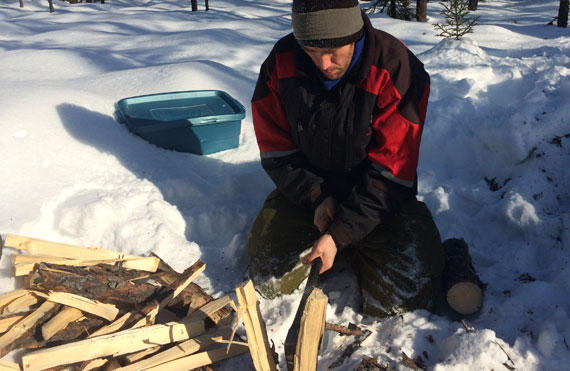 I held on and managed to right the sled. The only way to stop it, however, was to apply pressure on the brakes—a rubber tread that catches snow and signals the dogs to stop. In the two feet of unpacked powder, where trying to stand upright without a snowshoe or ski makes you sink, there was only one way to do it. I pulled myself up and jammed my knee down. “Pas bouger!" (“Don't move!") I commanded. It was a phrase I heard from Gravelle many times to keep his team behaved. My dogs came to a halt. Eventually, we re-packed the sled, gave the dogs a pep talk, and continued the journey. This mishap I learned, along with every bruise and scrape I bore, was a part of real dog sledding. True mushing will test any outdoor lover and I myself was humbled from my experience—but at least I could cross it off my to-do list. I will say that if you're ready for some real winter adventure, it sure beats doing it the easy way.
I held on and managed to right the sled. The only way to stop it, however, was to apply pressure on the brakes—a rubber tread that catches snow and signals the dogs to stop. In the two feet of unpacked powder, where trying to stand upright without a snowshoe or ski makes you sink, there was only one way to do it. I pulled myself up and jammed my knee down. “Pas bouger!" (“Don't move!") I commanded. It was a phrase I heard from Gravelle many times to keep his team behaved. My dogs came to a halt. Eventually, we re-packed the sled, gave the dogs a pep talk, and continued the journey. This mishap I learned, along with every bruise and scrape I bore, was a part of real dog sledding. True mushing will test any outdoor lover and I myself was humbled from my experience—but at least I could cross it off my to-do list. I will say that if you're ready for some real winter adventure, it sure beats doing it the easy way.

